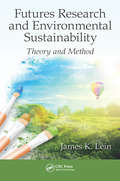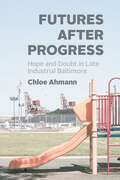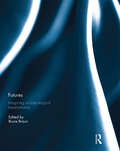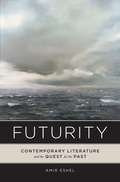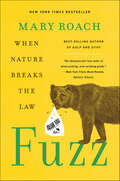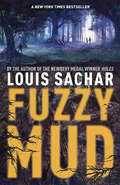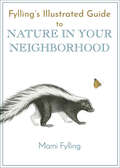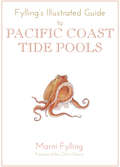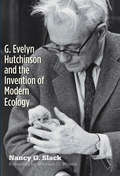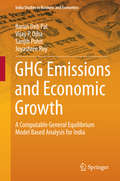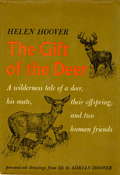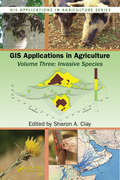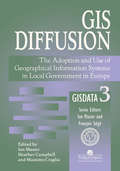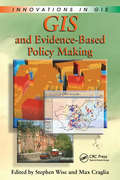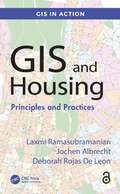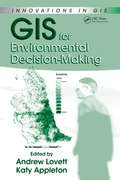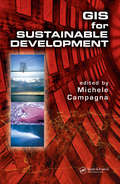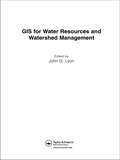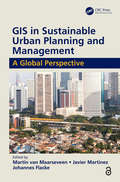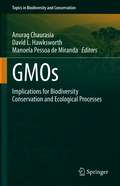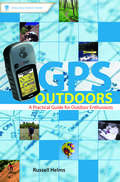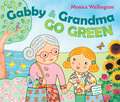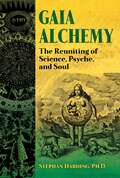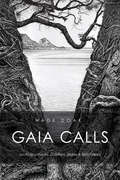- Table View
- List View
Futures Research and Environmental Sustainability: Theory and Method
by James K. LeinThis book explores the challenges of presenting sustainability as a more actionable or practical concept and identifying approaches that might offer useful assistance in addressing the temporal and spatial representation of sustainability. The underlying premise of this book is that sustainability is a state realized in the future. In that future there is a geographic arrangement of society and economy that agrees with its environmental setting. This future perspective introduces a little examined subject area that can lend significant content to the sustainability challenge: Futures Research.
Futures after Progress: Hope and Doubt in Late Industrial Baltimore
by Chloe AhmannA powerful ethnographic study of South Baltimore, a place haunted by toxic pasts in its pursuit of better futures. Factory fires, chemical explosions, and aerial pollutants have inexorably shaped South Baltimore into one of the most polluted places in the country. In Futures after Progress, anthropologist Chloe Ahmann explores the rise and fall of industrial lifeways on this edge of the city and the uncertainties that linger in their wake. Writing from the community of Curtis Bay, where two hundred years of technocratic hubris have carried lethal costs, Ahmann also follows local efforts to realize a good future after industry and the rifts competing visions opened between neighbors. Examining tensions between White and Black residents, environmental activists and industrial enthusiasts, local elders and younger generations, Ahmann shows how this community has become a battleground for competing political futures whose stakes reverberate beyond its six square miles in a present after progress has lost steam. And yet—as one young resident explains—“that’s not how the story ends.” Rigorous and moving, Futures after Progress probes the deep roots of our ecological predicament, offering insight into what lies ahead for a country beset by dreams deferred and a planet on the precipice of change.
Futures: Imagining Socioecological Transformation
by Bruce BraunFutures: Imagining Socioecological Transformation brings together leading scholars to explore how we might know, enact, and struggle for, the conjoined social and ecological transformations we need to achieve just and sustainable futures. The question of transformation, and how it might be achieved, is explored across a variety of topics and geographical sites, and through heterodox analytical and theoretical approaches, in a collective effort to move beyond a form of critique that hands down judgements, to one that brings new ideas and new possibilities to life. Chapters are lively and original engagements with concrete situations that sparkle with creativity. Together, they add up to an impressive study of how to live, and what to struggle for, in the complex socioecological landscapes of the Anthropocene. This book was previously published as a special issue of the Annals of the Association of American Geographers.
Futurity: Contemporary Literature and the Quest for the Past
by Amir EshelWhen looking at how trauma is represented in literature and the arts, we tend to focus on the weight of the past. In this book, Amir Eshel suggests that this retrospective gaze has trapped us in a search for reason in the madness of the twentieth century’s catastrophes at the expense of literature’s prospective vision. Considering several key literary works, Eshel argues in Futurity that by grappling with watershed events of modernity, these works display a future-centric engagement with the past that opens up the present to new political, cultural, and ethical possibilities—what he calls futurity. Bringing together postwar German, Israeli, and Anglo-American literature, Eshel traces a shared trajectory of futurity in world literature. He begins by examining German works of fiction and the debates they spurred over the future character of Germany’s public sphere. Turning to literary works by Jewish-Israeli writers as they revisit Israel’s political birth, he shows how these stories inspired a powerful reconsideration of Israel’s identity. Eshel then discusses post-1989 literature—from Ian McEwan’s Black Dogs to J. M. Coetzee’s Diary of a Bad Year—revealing how these books turn to events like World War II and the Iraq War not simply to make sense of the past but to contemplate the political and intellectual horizon that emerged after 1989. Bringing to light how reflections on the past create tools for the future, Futurity reminds us of the numerous possibilities literature holds for grappling with the challenges of both today and tomorrow.
Fuzz: When Nature Breaks the Law
by Mary RoachAn Instant New York Times Bestseller #1 Los Angeles Times Bestseller #1 Indie Hardcover Nonfiction Bestseller A Publishers Weekly Best Nonfiction Book of 2021 Longlisted for the 2022 Andrew Carnegie Medal for Excellence in Nonfiction Join "America’s funniest science writer" (Peter Carlson, Washington Post), Mary Roach, on an irresistible investigation into the unpredictable world where wildlife and humans meet.What’s to be done about a jaywalking moose? A bear caught breaking and entering? A murderous tree? Three hundred years ago, animals that broke the law would be assigned legal representation and put on trial. These days, as New York Times best-selling author Mary Roach discovers, the answers are best found not in jurisprudence but in science: the curious science of human-wildlife conflict, a discipline at the crossroads of human behavior and wildlife biology.Roach tags along with animal-attack forensics investigators, human-elephant conflict specialists, bear managers, and "danger tree" faller blasters. Intrepid as ever, she travels from leopard-terrorized hamlets in the Indian Himalaya to St. Peter’s Square in the early hours before the pope arrives for Easter Mass, when vandal gulls swoop in to destroy the elaborate floral display. She taste-tests rat bait, learns how to install a vulture effigy, and gets mugged by a macaque.Combining little-known forensic science and conservation genetics with a motley cast of laser scarecrows, langur impersonators, and trespassing squirrels, Roach reveals as much about humanity as about nature’s lawbreakers. When it comes to "problem" wildlife, she finds, humans are more often the problem—and the solution. Fascinating, witty, and humane, Fuzz offers hope for compassionate coexistence in our ever-expanding human habitat.
Fuzzy Mud
by Louis SacharFifth grader Tamaya Dhilwaddi and seventh grader Marshall Walsh have been walking to and from Woodbridge Academy together since elementary school. But their routine is disrupted when bully Chad Wilson challenges Marshall to a fight. To avoid the conflict, Marshall takes a shortcut home through the off-limits woods. Tamaya reluctantly follows. They soon get lost, and they find trouble. Bigger trouble than anyone could ever have imagined. In the days and weeks that follow, the authorities and the government become involved, and what they uncover might affect the future of the world. <P><b> Nominee for the 2018 Young Reader's Choice Award </b> <i>(Pacific Northwest Library Association)</i>
Fuzzy Mud (Penworthy Picks Middle School Ser.)
by Louis SacharFifth grader Tamaya Dhilwaddi and seventh grader Marshall Walsh have been walking to and from Woodridge Academy together since elementary school. But their routine is disrupted when bully Chad Hilligas challenges Marshall to a fight. To avoid the conflict, Marshall takes a shortcut home through the off-limits woods. Tamaya, unaware of the reason for the detour, reluctantly follows. They soon get lost. And then they find trouble. Bigger trouble than anyone could ever have imagined. In the days and weeks that follow, the authorities and the U.S. Senate become involved, and what they uncover might affect the future of the world. <P><b> Nominee for the 2018 Young Reader's Choice Award </b> <i>(Pacific Northwest Library Association)</i>
Fylling's Illustrated Guide to Nature in Your Neighborhood (Fylling's Illustrated Guides #2)
by Marni FyllingIn the same lighthearted yet scientifically accurate style of Fylling’s Illustrated Guide to Pacific Coast Tide Pools, this portable guidebook reveals the splendidly strange animals and plants just outside your door. Marni Fylling’s full-color illustrations make species identification a snap, and concise descriptions include fascinating (and sometimes grotesque) factoids about frequently encountered plants, insects, arachnids, birds, and mammals. With Fylling’s guidance, the everyday becomes extraordinary: Pigeons share nest-building and egg-sitting duties, and mate for life—with occasional dalliances; squirrel teeth grow about six inches per year; spiders owe their characteristic creep to their &“hydraulic&” legs; poison oak and poison ivy’s itch-inducing oil is also found in pistachios, cashews, and mangoes; and much, much more.
Fylling's Illustrated Guide to Pacific Coast Tide Pools (Fylling's Illustrated Guides #1)
by Marni FyllingThis scientifically accurate yet utterly charming field guide to the Pacific coast intertidal zone introduces readers to a world populated by spectacular wildlife: 150-year-old giant green anemones that paralyze their prey with their petal-like tentacles; sunflower sea stars that traverse the tide pool floor on twenty-four limbs; orange-tipped, opalescent sea slugs that dabble in cannibalism; and much, much more. Small enough to fit in a back pocket during a beach hike, the guide contains concise descriptions of tide pools' most common residents, noting each organism's size and zonation, as well as a few of its fascinating (and sometimes grotesque) habits. Full-color illustrations reminiscent of prints by Ernst Haeckel help tide poolers with easy identification.
G. Evelyn Hutchinson and the Invention of Modern Ecology
by Nancy G. SlackStephen J. Gould declared G. Evelyn Hutchinson the most important ecologist of the twentieth century. E.O. Wilson pronounced him "one of the few scientists who could unabashedly be called a genius." In this fascinating book, Nancy G. Slack presents for the first time the full life story of this brilliant scientist who was also a master teacher, a polymath, and a delightful friend and correspondent. Based on full access to Hutchinson's archives and extensive interviews with him and many who knew him, the author evaluates his important contributions to modern ecology and his profound influence as a mentor. Filled with information available nowhere else, the book draws a vibrant portrait of an original scientific thinker who was also a man of remarkable personal appeal.
GHG Emissions and Economic Growth
by Sanjib Pohit Barun Deb Pal Vijay P. Ojha Joyashree RoyIssues linking climate change and economic growth are now at the centre of discussions regarding development strategies especially in the context of developing countries. This book contributes by analyzing the relationship between economic growth and GHG emissions in India with explicit reference to all major economic sectors. One of the most popular tools for macroeconomic policy analysis is Social Accounting Matrix (SAM). The book presents the methods and estimates of the latest Social Accounting Matrix (SAM) for India, which provides a major data base describing the complete circular flow of income and input-output transactions among the sectors of the economy. The novelty of the book lies in the fact that for the first time a SAM has been prepared for the Indian economy with environmental indicators. A detailed methodology for constructing such an extended SAM is also presented in the book. The environmental social accounting matrix (ESAM) based analysis has been included to show direct and indirect links between economic growth and GHG emissions. The book also includes analysis of factors affecting historical GHG emissions trends in India. The book goes beyond SAM and applies computable general equilibrium (CGE) modelling to derive climate-change policy analysis and simulations. This CGE-based analysis is an important contribution to the current debate surrounding carbon tax and its possible impact on macroeconomic growth.
GIFT OF DEER
by Helen HooverIn the farthest wilds of northeastern Minnesota, back in the Gunflint Range, the author of this book and her artist-husband have a two-room cabin home in the bush country. Beginning one Christmas Day when they first watched the starving deer they later named Peter, the Hoovers had many opportunities, a passionate inclination, and the nature skills to observe this whitetail buck--joined later by his mate, and finally by several of their offspring--through the changing seasons of four years. Close as their relationship was to the generations of beautiful animals, the Hoovers did not consider them pets but fellow inhabitants of that wild country. Their observations reveal the rewards of living close to wild creatures; but more than that, they add valuable information to our knowledge of the cycle of life of the deer and other creatures native to the same world. For although the deer are the chief characters of this book, they are by no means the only wild creatures Mrs. Hoover writes of. Her naturalist's eye is just as sharp and her affection just as great for the antics of a curious chickadee or a flying squirrel. Mrs. Hoover's identification with nature knows no favoritism. The Hoovers' world--the bush country of the United States-Canadian border--is farther removed from civilization than "Mr. Emerson's woodlot," but the close relationship of The Gift of the Deer to Walden is evident for all to enjoy. Adrian Hoover's drawings are from life, and they add another level of understanding to his wife's vivid prose.
GIS Applications in Agriculture, Volume Three: Invasive Species (GIS Applications in Agriculture)
by Sharon A. ClayWhile many "alien" plant and animal species are purposefully introduced into new areas as ornamentals, livestock, crops, and even pets, these species can escape into other areas and threaten agricultural and native ecosystems causing economic and environmental harm, or harm to human health. Increasingly, scientists are using Geographic Information Systems (GIS) to track and manage the invaders, mitigate the potential rate of spread and level of impact, and protect the native economy and ecosystem.Beginning with an introduction to the use of GIS technology to capture, store, analyze, manage, and present data, GIS Applications in Agriculture, Volume Three: Invasive Species examines five relevant categories of geographic information including dispersal and transport, prediction and forecasting, mapping of current infestations, maps for management and control tactics, and impact assessment and method of control. It address GIS for studying the population ecology of a new species, niche requirements for species success, and the monitoring and control of several different species including Australian examples of intentionally introduced invasive species, insects and other animals that may also vector a disease, and invasive weed management from prediction to management. Chapters cover maps and imageries available on various Web sites and provide step-by-step tutorials or case studies that allow manipulation of datasets featured on the accompanyingdownloadable resources to make maps, perform statistical analyses, and predict future problems. It offers hands-on experience with a variety of software programs that create interactive queries (user-created searches), analyze spatial information, edit data and maps, and present the results of these operations in several different formats. Some of the programs are freeware, others are not, but each can be used to integrate, edit, share, and display geographic information. Color figures are
GIS Diffusion: The Adoption And Use Of Geographical Information Systems In Local Government in Europe
by Ian Masser; Heather Campbell; Massimo CragliaThis third book in the GISDATA series focuses on the widespread use of geographical information systems GIS in European local government. The editors include a wide range of applications carried out by different professional groups, and offer the opportunity of studying the extent to which diffusion of innovations like GIS are sensitive to national issues such as cultural context, institutional setup and the availability of data.; The book answers key questions such as: what can be learnt from research on organizational behaviour in relation to technological innovation?; what are the classical features of the GIS diffusion process?; to what extent is the adoption and utilization of GIS facilitated - or impeded - by the organizational culture within which it takes place?; and what mechanisms can be applied to enhance the diffusion of GIS? The book covers aspects of diffusion in the following European countries: UK, France, Italy, Poland, Denmark, The Netherlands, Germany, Greece and Portugal.
GIS and Evidence-Based Policy Making
by Stephen Wise Max CragliaAlthough much has been written on evidence-based policy making, this is the first volume to address the potential of GIS in this arena. GIS and Evidence-Based Policy Making covers the development of new methodological approaches, emphasizing the identification of spatial patterns in social phenomena. It examines organizational issues, including the
GIS and Housing: Principles and Practices (GIS in Action)
by Laxmi Ramasubramanian Jochen Albrecht Deborah Rojas De LeonGIS and Housing: Principles and Practices discusses one of the challenges that has not been addressed by Geographic Information Science thus far: how can we use GIS to deal with the complex issues underlying the housing crisis? This book provides GIS technicians and analysts with an overview of US housing challenges and examples of how to effectively integrate spatial thinking to address housing policy questions, while simultaneously introducing housing policy analysts to advanced GIS concepts and techniques to create livable neighborhoods that include housing alternatives beyond the single family. Through numerous examples, the authors advocate for a collaborative approach that encourages professionals, policymakers, and analysts, across different ideological and political perspectives, to confront the multifaceted housing crisis. Features: Examines the historical aspects of housing provision, societal attitudes, demographic shifts, and government policies. Bridges the gaps between housing professionals and GIS experts, facilitating an interdisciplinary approach to address the housing crisis. Explores different challenges that are facing urban, suburban, and rural neighborhoods in different US regions. Provides professionals with the necessary tools for informed decision-making. Proposes solutions that leverage the integrative capacity of GIS to address established housing issues. Advocates for denser housing alternatives to address issues of affordability, supply shortages, and homelessness. This book is intended for graduate students and professionals in housing, community development, urban planning, architecture, and GIS, and anyone curious about learning more about the American housing crisis.
GIS for Environmental Decision-Making (Innovations in GIS)
by Andrew Lovett Katy AppletonEnvironmental applications have long been a core use of GIS. However, the effectiveness of GIS-based methods depends on the decision-making frameworks and contexts within which they are employed. GIS for Environmental Decision-Making takes an interdisciplinary look at the capacities of GIS to integrate, analyze, and display data on which decisions
GIS for Sustainable Development
by Michele CampagnaGIS for Sustainable Development examines how GIS applications can improve collaboration in decision making among those involved in promoting sustainable development. This volume reviews leading GIScience, providing an overview of research topics and applications that enable GIS newcomers and professionals to apply GIScience methods to susta
GIS for Water Resource and Watershed Management
by John G. LyonThe use of GIS, and its application for solving environmental problems is growing rapidly. This powerful set of tools can be used to great effect in hydrological modeling, environment and habitat assessments, ecosystem studies, monitoring of wetlands and forested watersheds, urban studies, agricultural impact assessment and much more. GIS for Water
GIS in Sustainable Urban Planning and Management (Open Access): A Global Perspective
by Martin Van Maarseveen Javier Martinez Johannes FlackeThe Open Access version of this book, available at http://www.tandfebooks.com/doi/view/10.1201/9781315146638, has been made available under a Creative Commons Attribution-Non Commercial-No Derivatives 3.0 license. <P><P> GIS is used today to better understand and solve urban problems. GIS in Sustainable Urban Planning and Management: A Global Perspective, explores and illustrates the capacity that geo-information and GIS have to inform practitioners and other participants in the processes of the planning and management of urban regions. The first part of the book addresses the concept of sustainable urban development, its different frameworks, the many ways of measuring sustainability, and its value in the urban policy arena. The second part discusses how urban planning can shape our cities, examines various spatial configurations of cities, the spread of activities, and the demands placed on different functions to achieve strategic objective. It further focuses on the recognition that urban dwellers are increasingly under threat from natural hazards and climate change. <P><P> Written by authors with expertise on the applications of geo-information in urban management, this book showcases the importance of GIS in better understanding current urban challenges and provides new insights on how to apply GIS in urban planning. It illustrates through real world cases the use of GIS in analyzing and evaluating the position of disadvantaged groups and areas in cities and provides clear examples of applied GIS in urban sustainability and urban resilience. <P><P> The idea of sustainable development is still very much central in the new development agenda of the United Nations, and in that sense, it is of particular importance for students from both the Global South and Global North. Professionals, researchers, and students alike will find this book to be an invaluable resource for understanding and solving problems relating to sustainable urban planning and management.
GMOs: Implications for Biodiversity Conservation and Ecological Processes (Topics in Biodiversity and Conservation #19)
by David L. Hawksworth Anurag Chaurasia Manoela Pessoa de MirandaThis book covers a broad spectrum of topics related to GMOs and allied new gene-based technologies, biodiversity, and ecosystem processes, bringing together the contributions of researchers and regulators from around the world. The aim is to offer a clear view of the benefits and effects of genetically modified crops, insects, and other animals on the soil microbiome and ecological processes. Contributors examine issues related to the development of risk assessment procedures and regulations designed to maximize benefits while minimizing risks. Beyond the scientific challenges of GMOs, the book explores the broad and contentious terrain of ethical considerations. The contributors discuss such questions as the unintended, possibly unforeseen, consequences of releasing GMOs into ecosystems, and the likelihood that the full effects of GMOs could take years, even decades, of close monitoring to become evident. The importance of developing a precautionary approach is stressed. The final chapter describes the critical issues of governance and regulation of new and emerging gene-based technologies, as nations grapple with the consequences of adopting the Cartagena Protocol on Biosafety (CPB). The volume includes an extensive Annex which outlines legal perspectives on the state of GMO governance around the world, with more than 20 examples from nations in Africa, South and Central America, Asia, Australasia, and Europe.
GPS Outdoors
by Russell HelmsFor about $150 anyone can access the United States' multi-billion dollar GPS program. Using GPS Outdoors: A Practical Guide for Hikers, Bikers, Paddlers, and Climbers shows readers how to plug in and enhance most any outdoor experience.Whether a hiker on a weekend trip through the Great Smokies, a backpacker cruising the Continental Divide Trail, a mountain biker kicking up dust in Moab, a paddler running the Lewis and Clark bicentennial route, or a climber pre-scouting the routes up Mount Shasta, a simple handheld GPS unit is fun, useful, and can even be a lifesaver.Described in conjunction with today's most popular GPS software, easy to understand information enables readers to:- Plan a trip- Navigate along a route- Gather data from the outing- Analyze trip data after the tripInformation is power, and a GPS unit is today's preferred tool to harness the power of navigational technology for a more enjoyable, more informative, and possibly safer outdoor experience.
Gabby and Grandma Go Green
by Monica WellingtonWhen Gabby and Grandma get together, "Green Day" means "Fun Day." From sewing their own cloth bags and buying vegetables at the Farmers' Market to recycling their bottles, these two know how to have a good time while doing good things for the earth. The illustrations in Monica Wellington's popsicle-bright palette-enhanced with myriad shades of green-result in a perfectly "green" addition to her books for the very young.
Gaia Alchemy: The Reuniting of Science, Psyche, and Soul
by Stephan Harding• Examines how integrating important alchemical images with Gaian science can offer insights into our interconnectedness with Gaia • Looks at how the four components of the living earth--biosphere, atmosphere, hydrosphere, and lithosphere--mesh with the four elements of alchemical theory and the four functions of consciousness as understood by depth psychology • Offers guided meditations and contemplative exercises to open your receptivity to messages from the biosphere and help you connect more deeply with Gaia During the scientific revolution, science and soul were drastically separated, propelling humanity into four centuries of scientific exploration based solely on empiricism and rationality. But, as scientist and ecologist Stephan Harding, Ph.D., demonstrates in detail, by reintegrating science with profound personal experiences of psyche and soul, we can reclaim our lost sacred wholeness and help heal ourselves and our planet. Harding begins with compelling introductions to depth psychology, alchemy, and Gaia theory--the science of seeing the Earth as an intelligent, self-regulating system, a theory pioneered by his mentor James Lovelock. He then explores how alchemy, as understood through the depth psychology of C. G. Jung, offers us powerful methods of reuniting rationality and intuition, science and soul. He examines the integration of important alchemical engravings, including L&’Azoth des Philosophes and the Rosarium Philosophorum, with Gaian science. He shows how the seven key alchemical operations in the Azoth image can help us develop deeply transformative experiences and insights into our interconnectedness with Gaia. He then looks at how the four components of the living Earth--biosphere, atmosphere, hydrosphere, and lithosphere--mesh not only with the four elements of alchemical theory but also with the four functions of consciousness from depth psychology. Woven throughout with the author&’s own experiences of Gaia alchemy, the book also offers guided meditations, shamanic practices, and contemplative exercises to open your receptivity to messages from the biosphere and help you develop your own Gaia alchemical way of life, full of wonder and healing.
Gaia Calls
by Wade DoakWade Doak is one of the world's leading marine explorers. In Gaia Calls he takes his readers on a unforgettable journey. From his first discovery of the sunken treasure of the Elingamite, to life as a young man in the Solomon Islands living among the islanders, to years of dolphin research, diving adventures, and his discovery of interspecies communication. With patience, focus, and respect he shares his knowledge and love for the natural world, and leads his readers to a deeper understanding of the interconnectedness of all life. A fascinating and engaging document of a life well lived.
